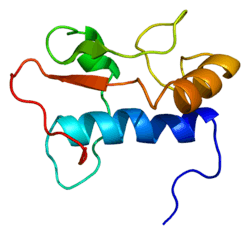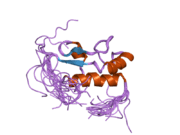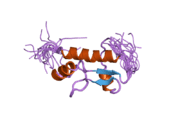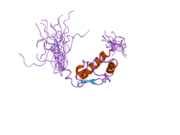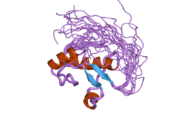GTF2IRD1
| View/Edit Human | View/Edit Mouse |
General transcription factor II-I repeat domain-containing protein 1 is a protein that in humans is encoded by the GTF2IRD1 gene.[3][4][5]
The protein encoded by this gene contains five GTF2I-like repeats and each repeat possesses a potential helix-loop-helix (HLH) motif. It may have the ability to interact with other HLH-proteins and function as a transcription factor or as a positive transcriptional regulator under the control of Retinoblastoma protein. This gene is deleted in Williams-Beuren syndrome, a multisystem developmental disorder caused by deletion of multiple genes at 7q11.23. Alternative splicing of this gene generates at least 2 transcript variants.[5]
References
- ↑ "Human PubMed Reference:".
- ↑ "Mouse PubMed Reference:".
- ↑ O'Mahoney JV, Guven KL, Lin J, Joya JE, Robinson CS, Wade RP, Hardeman EC (November 1998). "Identification of a novel slow-muscle-fiber enhancer binding protein, MusTRD1". Mol Cell Biol. 18 (11): 6641–52. PMC 109249
 . PMID 9774679.
. PMID 9774679. - ↑ Osborne LR, Campbell T, Daradich A, Scherer SW, Tsui LC (May 1999). "Identification of a putative transcription factor gene (WBSCR11) that is commonly deleted in Williams-Beuren syndrome". Genomics. 57 (2): 279–84. doi:10.1006/geno.1999.5784. PMID 10198167.
- 1 2 "Entrez Gene: GTF2IRD1 GTF2I repeat domain containing 1".
Further reading
- Tassabehji M, Carette M, Wilmot C, et al. (2000). "A transcription factor involved in skeletal muscle gene expression is deleted in patients with Williams syndrome.". Eur. J. Hum. Genet. 7 (7): 737–47. doi:10.1038/sj.ejhg.5200396. PMID 10573005.
- Franke Y, Peoples RJ, Francke U (2000). "Identification of GTF2IRD1, a putative transcription factor within the Williams-Beuren syndrome deletion at 7q11.23.". Cytogenet. Cell Genet. 86 (3-4): 296–304. doi:10.1159/000015322. PMID 10575229.
- Yan X, Zhao X, Qian M, et al. (2000). "Characterization and gene structure of a novel retinoblastoma-protein-associated protein similar to the transcription regulator TFII-I.". Biochem. J. 345 Pt 3: 749–57. doi:10.1042/0264-6021:3450749. PMC 1220813
 . PMID 10642537.
. PMID 10642537. - Tussié-Luna MI, Bayarsaihan D, Ruddle FH, Roy AL (2001). "Repression of TFII-I-dependent transcription by nuclear exclusion.". Proc. Natl. Acad. Sci. U.S.A. 98 (14): 7789–94. doi:10.1073/pnas.141222298. PMC 35420
 . PMID 11438732.
. PMID 11438732. - Tussie-Luna MI, Michel B, Hakre S, Roy AL (2003). "The SUMO ubiquitin-protein isopeptide ligase family member Miz1/PIASxbeta /Siz2 is a transcriptional cofactor for TFII-I.". J. Biol. Chem. 277 (45): 43185–93. doi:10.1074/jbc.M207635200. PMID 12193603.
- Tussié-Luna MI, Bayarsaihan D, Seto E, et al. (2002). "Physical and functional interactions of histone deacetylase 3 with TFII-I family proteins and PIASxbeta.". Proc. Natl. Acad. Sci. U.S.A. 99 (20): 12807–12. doi:10.1073/pnas.192464499. PMC 130541
 . PMID 12239342.
. PMID 12239342. - Vullhorst D, Buonanno A (2003). "Characterization of general transcription factor 3, a transcription factor involved in slow muscle-specific gene expression.". J. Biol. Chem. 278 (10): 8370–9. doi:10.1074/jbc.M209361200. PMID 12475981.
- Strausberg RL, Feingold EA, Grouse LH, et al. (2003). "Generation and initial analysis of more than 15,000 full-length human and mouse cDNA sequences.". Proc. Natl. Acad. Sci. U.S.A. 99 (26): 16899–903. doi:10.1073/pnas.242603899. PMC 139241
 . PMID 12477932.
. PMID 12477932. - Hillier LW, Fulton RS, Fulton LA, et al. (2003). "The DNA sequence of human chromosome 7.". Nature. 424 (6945): 157–64. doi:10.1038/nature01782. PMID 12853948.
- Polly P, Haddadi LM, Issa LL, et al. (2003). "hMusTRD1alpha1 represses MEF2 activation of the troponin I slow enhancer.". J. Biol. Chem. 278 (38): 36603–10. doi:10.1074/jbc.M212814200. PMID 12857748.
- Hirota H, Matsuoka R, Chen XN, et al. (2004). "Williams syndrome deficits in visual spatial processing linked to GTF2IRD1 and GTF2I on chromosome 7q11.23.". Genet. Med. 5 (4): 311–21. doi:10.1097/01.GIM.0000076975.10224.67. PMID 12865760.
- Lehner B, Sanderson CM (2004). "A protein interaction framework for human mRNA degradation.". Genome Res. 14 (7): 1315–23. doi:10.1101/gr.2122004. PMC 442147
 . PMID 15231747.
. PMID 15231747. - Beausoleil SA, Jedrychowski M, Schwartz D, et al. (2004). "Large-scale characterization of HeLa cell nuclear phosphoproteins.". Proc. Natl. Acad. Sci. U.S.A. 101 (33): 12130–5. doi:10.1073/pnas.0404720101. PMC 514446
 . PMID 15302935.
. PMID 15302935. - Gerhard DS, Wagner L, Feingold EA, et al. (2004). "The status, quality, and expansion of the NIH full-length cDNA project: the Mammalian Gene Collection (MGC).". Genome Res. 14 (10B): 2121–7. doi:10.1101/gr.2596504. PMC 528928
 . PMID 15489334.
. PMID 15489334. - Grimsby S, Jaensson H, Dubrovska A, et al. (2005). "Proteomics-based identification of proteins interacting with Smad3: SREBP-2 forms a complex with Smad3 and inhibits its transcriptional activity.". FEBS Lett. 577 (1-2): 93–100. doi:10.1016/j.febslet.2004.09.069. PMID 15527767.
- Jackson TA, Taylor HE, Sharma D, et al. (2005). "Vascular endothelial growth factor receptor-2: counter-regulation by the transcription factors, TFII-I and TFII-IRD1.". J. Biol. Chem. 280 (33): 29856–63. doi:10.1074/jbc.M500335200. PMID 15941713.
- Rual JF, Venkatesan K, Hao T, et al. (2005). "Towards a proteome-scale map of the human protein-protein interaction network.". Nature. 437 (7062): 1173–8. doi:10.1038/nature04209. PMID 16189514.
- Tassabehji M, Hammond P, Karmiloff-Smith A, et al. (2005). "GTF2IRD1 in craniofacial development of humans and mice.". Science. 310 (5751): 1184–7. doi:10.1126/science.1116142. PMID 16293761.
This article is issued from Wikipedia - version of the 6/28/2016. The text is available under the Creative Commons Attribution/Share Alike but additional terms may apply for the media files.
